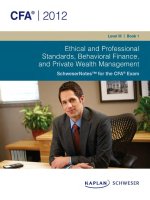Chapter 9 investments behavioral finance and technical analysis
Bạn đang xem bản rút gọn của tài liệu. Xem và tải ngay bản đầy đủ của tài liệu tại đây (442.73 KB, 16 trang )
Chapter 9
Behavioral Finance and
Technical Analysis
9.1 The Behavioral Critique
9-2
Behavioralism bias
Motivation
- Stock prices in the 1990s did not appear to match “fundamentals,”
e.g., high price earnings ratios
- Economics discipline is exploring behavioral aspects of decision
making
9-3
Behavioralism
Extrapolation bias
Overconfidence
- Analysts tend to excessively extrapolate historical trends when
forecasting.
- May lead to unsustainably high P/E ratios.
- Some people exhibit overconfidence in their ability to pick
stocks or have an exaggerated belief that ‘risk’ will hurt the
other person but not them. As a result, they bid stock prices
too high.
9-4
Behavioralism
Anchoring Bias & earnings
- Many people become anchored to their ideas and will
not update their expectations when new information
arrives.
- This underreaction to news leads to momentum in
stock returns.
9-5
Why not arbitrage mispriced stocks?
If some investors are letting behavioral biases affect prices, why don’t other better trained investor
s engage in profitable arbitrage?
9-6
Limits to arbitrage
Fundamental Risk
Short sale constraints
Model Risk
Changes in fundamentals can wipe out any
arbitrage profits, making the strategy risky.
Short sale constraints make it difficult to arbitrage
overpriced securities.
How do you know when a security is truly
mispriced? Your model may be giving you wrong
signals.
9-7
Critiquing the Behavioral Critique
•
It provides stories that fit individual situations but
there is no coherent theory put forth and
some behaviors contradict others.
•
Much of the empirical support for the behavioralist
ideas in investments comes from one specific time period,
the late 1990s.
•
The behavioral literature is very weak at providing
solutions to these problems.
9-8
9.2. Technical Analysis and Behavioral Finance
Attempts to exploit recurring and predictable patterns in stock prices to gene
rate superior investment performance.
Technicians do not deny the value of fundamental information, but believe th
at prices only gradually close in on intrinsic value.
- As fundamentals shift, astute traders can exploit the adjustment to a ne
w
equilibrium.
Technicians believe that market fundamentals can be perturbed by irrational
or behavior factors.
- Random price fluctuations will accompany any underlying price trend,
creating opportunities to exploit corrections as these fluctuations dissipat
e.
9-9
Basic Types of Technical Analysis
Dow Theory
•
Three types of trends, only two are important
•
Every stock has price peaks and troughs but if a series of
peaks and troughs are rising, it is a buy signal especially
if volume is heavier during the peaks than the troughs
9-10
Basic Types of Technical Analysis
Dow Theory
9-11
Point A – Bullish Signal Point B – Bearish Signal
9-13
Basic Types of Technical Analysis
Relative Strength
•
A simple relative strength ratio could be constructed as
___________.
•
Increases in the relative strength ratio indicate the stock is
outperforming the index or its particular industry and could
indicate a buy or bullish signal.
•
If relative strength can be assumed to persist over time,
then this would be a signal to buy it.
ΔPi / ΔIndex
9-14
A Warning About Identifying Trends
Difficulty in identifying common price patterns
One of these patterns is real and one of these is
computer simulated with random price changes.
Can you tell which is which?
9-15
9-16









